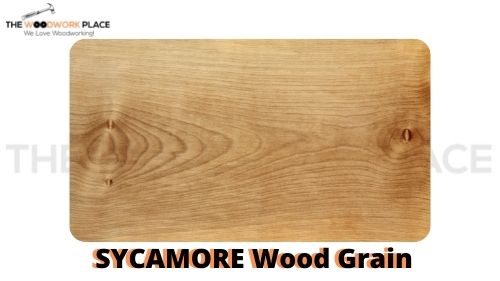Typically, the exact type of wood you use can have a major impact on how a woodwork project turns out. However, when it comes to woodturning, most any piece of wood you come across can be good enough to pop onto a lathe.
Related Post: 5 Clever Wood Turning Projects (For Lathe Beginners) | TheWoodworkPlace.com
In fact, there’s a chance that the best turning wood might be laying around (for free!) in your local area. The American Sycamore, (also known as the American Plane), is a tree that grows abundantly across North America.
And, if Sycamore trees are growing in your neighborhood, then you can hardly miss ‘em. These fast-growing trees can stretch up to 100 feet tall.
But, let’s say you’ve stumbled across a Sycamore log nearby. Is it worth bringing it home so you can turn it into something special?
Well, in this post, you will learn why Sycamore tends to be one of the easier hardwoods to carve and turn. You’ll also learn the top 3 pros and cons of working with this lumber…

This post may contain affiliate links to products that we receive a commission for (at no additional cost to you). Learn more here.
What Is Sycamore Timber Good For?
Sycamore is used to make everything from furniture to timber moldings.
It’s also used for wall paneling and wood carving. In fact, Sycamore ‘lovespoons’ were a popular traditional Welsh engagement gift in the 17th century.
Related Post: Is Sycamore Wood Good For Carving? | TheWoodworkPlace.com
Does Sycamore Take Stain Well?
Typified by its pale yellow grain, Sycamore growth rings are a visibly contrasting brown color.
Still, those rings aren’t distinct enough to really enhance the look of decorative crafts (like bowls or vases). This is why Sycamore wood is frequently painted or stained to give it more color and definition.
But, Sycamore takes on stain unevenly, leaving behind blotchy looking results.
You will need to prime the surface of Sycamore with a wood conditioner or pre-stain sealer, before applying any penetrating wood stain.
What Kind Of Grain Texture Does Sycamore Have?
The best type of turning timber are not only easy to carve, but they also have beautiful grain texture.
And unfortunately, Sycamore wood is not the most naturally eye-popping timber.

Is Sycamore A Closed Grain Wood?
The American Sycamore, (which is the Sycamore subspecies found growing in the USA and Canada), has close fine grain texture. This Sycamore wood also has what is referred to as ‘interlocking grain’.
When we say lumber has interlocking grain, we are describing the directional growth of it’s tree rings.
Trees with interlocking grain have tree rings that spiral in one direction for a few years. The rings then spiral in the reverse direction for a few more years, before spiraling back to repeat the cycle all over again.
These misaligned tree rings can make it difficult to plane down quarter-sawn Sycamore logs.
Related Post: Can You Use A Hand Planer On Plywood (Explained) | TheWoodworkPlace.com
However, interlocking grain shouldn’t be a problem when it comes to turning Sycamore wood.
Top 3 Sycamore Woodturning Pros
1). Sycamore Is Easy To Cut, Carve, And Chisel
Sycamore is fairly soft for a hardwood.
According to the Janka Hardness Scale, American Sycamore has a Janka rating of just 770 lbf. This means it takes just 770 lbs of force to make a dent in this timber… making it much softer than Maple wood.
It’s light for a hardwood too, weighing a mere 34 lbs per cubic foot.
2). Sycamore Is Widely Accessible
Sycamore is one of the most eco-friendly woods on the market, because it is so sustainable.
This tree grows abundantly around North America and also the British Isles. Which is why it’s one of the more affordable hardwoods you can get your hands on.
3). Sycamore Is Great For Turning Bowls
If you want to craft a large wooden bowl, then you can use Sycamore wood.
Sycamore trees are enormous, and have substantially large logs. So you can make larger-than-life pieces from start to finish… all from a single log.
Top 3 Sycamore Woodturning Cons
1). Very Dry Sycamore Is Hard To Turn
Sycamore wood that still has a bit of moisture left in it, is easy to turn. Yet, if that Sycamore piece is very dry, then cutting it is going to be difficult.
2). Sycamore Warps Easily
Sycamore isn’t a very stable wood.
When wood is first cut, it is filled with water. This freshly cut wood is then left to dry out before it can be used. This drying-out period is called ‘seasoning’.
A stable wood is one that doesn’t expand and contract much (if at all) after seasoning. For example, Douglas Fir is a very stable wood.
Related Post: Don’t Put Teak Oil On Douglas Fir (Use This Instead) | TheWoodworkPlace.com
Sycamore, on the other hand, is far from stable. If you keep seasoned Sycamore wood well away from water, then it won’t shift around.
However, if Sycamore takes on any water or moisture, then it will crack and split wide open (as it begins to dry out again).
So, don’t be surprised if your Sycamore turned bowl ends up with a crack (or two) in it.
3). Sycamore Does Not Absorb Finishes And Stains Evenly
Getting Sycamore to evenly absorb any penetrating oil, stain, finish or sealer, is going to be a job and a half.
To Sum Up…Is Sycamore Wood Good For Turning?
As a wood for practicing turning techniques on, its perfect. Sycamore wood is cheap, (even free if you look around your locale), and it’s straightforward to turn.
However, it is not a durable wood. So, you don’t want to use it to make anything other than decorative pieces. And, avoid using it to make any spoons and bowls meant for practical use as kitchen utensils.
References:
Brush, Warren D. “Distinguishing characters of North American sycamore woods.” Botanical Gazette 64.6 (1917): 480-496.
